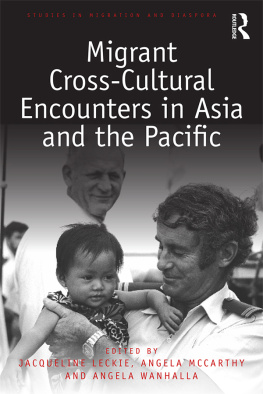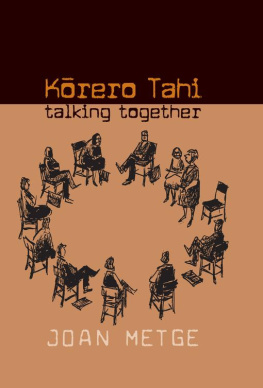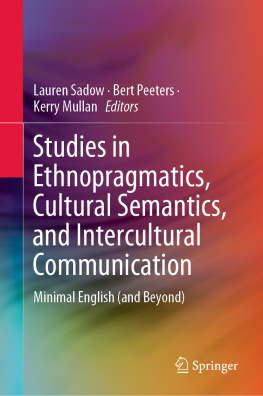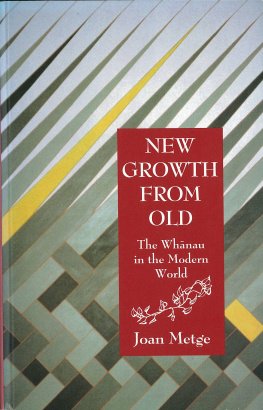It has become fashionable to refer to New Zealand as a multicultural society, which is one way of saying that the population comprises more than one cultural group. It does not mean that a majority of New Zealand citizens are knowledgeable about other cultures than their own. Certain minority groups, notably the Maoris and other Polynesians, are generally identified as falling below the average level of education and socio-economic achievement. Those engaged in the provision of services in various fieldsearly childhood care, schools, health care, social welfare, marriage guidance, etc.are concerned that these groups are not taking full advantage of the services they offer. But efforts to encourage greater involvement run into difficulties. Without denying the contribution of other factors (such as social and economic pressures), we should like to focus attention on the problems that arise because of cultural differences, especially those which are not recognised as such.
By and large the wide range of official and voluntary services available to citizens in New Zealand are built upon premises, research and values derived from the majority (Pakeha) culture. Those staffing these services are predominantly Pakeha and vary widely in their knowledge of other cultures. Because of this members of minority groups often shy away from these services altogether, whether from feelings of inadequacy or because they see them as threatening their own cultural values. Or else they seek out particular branches, because of the presence of staff members knowledgeable about and/or sympathetic to their group, because of congenial informality, or because of the reassuring predictability of a formal set-up. Where members of different cultural groups do come together in formal and informal situations, misunderstandings and tensions arise even where there is the greatest goodwill on both sides, misunderstandings which the parties themselves find it hard to explain.
On the basis of our experience working with Maoris and Samoans in their dealings with Pakehas, we the writers of this paper have become convinced that a good deal of miscommunication occurs between members of these groups because the parties interpret each others words and actions in terms of their own understandings, assuming that these are shared when in fact they are notin other words, because of cultural differences that are not recognised because we all take our own culture very largely for granted and do not question its general applicability. These understandings are acquired in the process of growing up in a culture and most become so thoroughly internalised that we cease to be aware of them, coming to think of them (if at all) as natural or at least second nature, not only the right but the only conceivable way of doing and looking at things, identifying our way as the human way. We are more ready than we used to be to recognise and respect cultural differenceswhere they are particularly striking. The Maori tangihanga for instance is nowadays recognised as an acceptable way of mourning the dead and no longer widely denigrated as pagan, morbid and wasteful. But differences that are less obvious and involve individuals rather than groups frequently go quite unrecognised. When Maoris, Pakehas and Samoans act on the assumption that they give particular words and actions the same meaning while actually giving them different ones, they talk past each other, misread each others words and actions, respond inappropriately , and judge each other as stupid, odd or rude in the light of their own standards. And because this happens below the level of conscious awareness they can go on making the same mistakes indefinitely, failing to connect, feeling irritated and confused, unless someone opens their eyes to what is happening.
During 1977 we set out, separately but in association, to check and develop this insight by observation, interviews and group discussions involving Maoris, Pakehas and Samoans separately and together. The body of this paper represents the fruit of these discussions, integrated with and checked by our own experience. When we speak of Maoris, Pakehas and Samoans in the following pages we are talking, in general terms, of the ideas and practices typical of Maoris, Pakehas and Samoans as groups. We do not mean to imply that every single person who could be identified as Maori, Pakeha or Samoan necessarily holds the ideas or behaves in the way described. We do, however, believe that the ideas and behaviour in question are sufficiently common among members of each group for themselves and/or others to consider them characteristic, and should at least be considered in any attempt to understand inter-group relations.
VERBAL AND NON-VERBAL COMMUNICATION
Members of all three groups talk with their bodies as well as their tongues, but Maoris and Samoans emphasise body language more and verbalisation less than Pakehas. Pakehas who define communication primarily in terms of verbal expression typically find Maoris and Samoans unresponsive and hard to talk to, while all the while they themselves are failing to pick up much of the communication directed their way because they are listening with their ears instead of their eyes. To Maoris and Samoans, Pakehas often seem deaf to what others are trying to tell them, while at the same time they are forever talking. This is not of course objectively true, but the quiet ones are submerged by the talkers. So many of the words Pakehas use seem unnecessary, so many of the things they say seem trivial, that Maori and Samoan listeners often cut outand then respond inappropriately because they did not get the message.
INDICATING AGREEMENT AND DISAGREEMENT
Pakehas usually say yes and no, reinforcing the words with a nod or a shake of the head. They accept the words without the action; but regard the actions without the words as inadequate and rude except in situations of intimacy. Maoris and Samoans on the other hand frequently dispense with the verbal forms and rely on gestures only without considering this rude. They recognise the nod and headshake as yes and no but commonly use other indicators: an upward movement of the head and/or eyebrows for yes, and an unresponsive starestraight ahead or down at the feetfor no. These are easily misread. A Pakeha infant teacher related how she found she was continually repeating herself to her predominantly Polynesian class. She established that she was doing it in response to the raised eyebrows gesture which she had interpreted as Please say it again, and realised that they were in fact signalling Yes, we understand. However, though Pakehas so often interpret raised eyebrows as a question, if you watch carefully, you will find that they use variations of it with other meanings, especially to indicate recognition, for instance if friends meet where words are precluded by distance, too much noise or a rule of silence.








